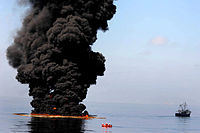
Photo from wikipedia
Air quality models are used to assess the impact of smoke from wildland fires, both prescribed and natural, on ambient air quality and human health. However, the accuracy of these… Click to show full abstract
Air quality models are used to assess the impact of smoke from wildland fires, both prescribed and natural, on ambient air quality and human health. However, the accuracy of these models is limited by uncertainties in the parametrisation of smoke plume injection height (PIH) and its vertical distribution. We compared PIH estimates from the plume rise method (Briggs) in the Community Multiscale Air Quality (CMAQ) modelling system with observations from the 2013 California Rim Fire and 2017 prescribed burns in Kansas. We also examined PIHs estimated using alternative plume rise algorithms, model grid resolutions and temporal burn profiles. For the Rim Fire, the Briggs method performed as well or better than the alternatives evaluated (mean bias of less than ±5-20% and root mean square error lower than 1000 m compared with the alternatives). PIH estimates for the Kansas prescribed burns improved when the burn window was reduced from the standard default of 12 h to 3 h. This analysis suggests that meteorological inputs, temporal allocation and heat release are the primary drivers for accurately modelling PIH.
Journal Title: International journal of wildland fire
Year Published: 2022
Link to full text (if available)
Share on Social Media: Sign Up to like & get
recommendations!